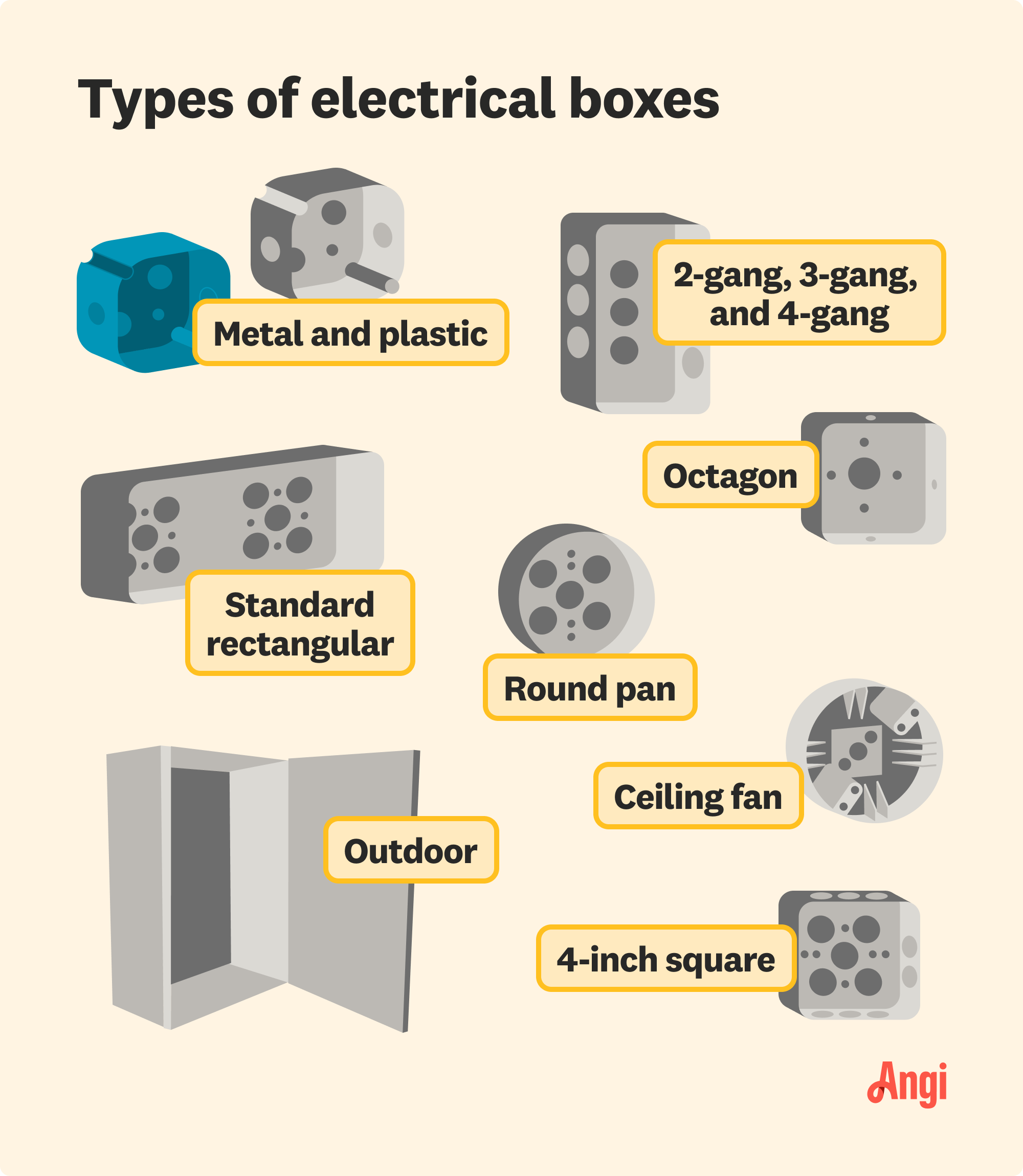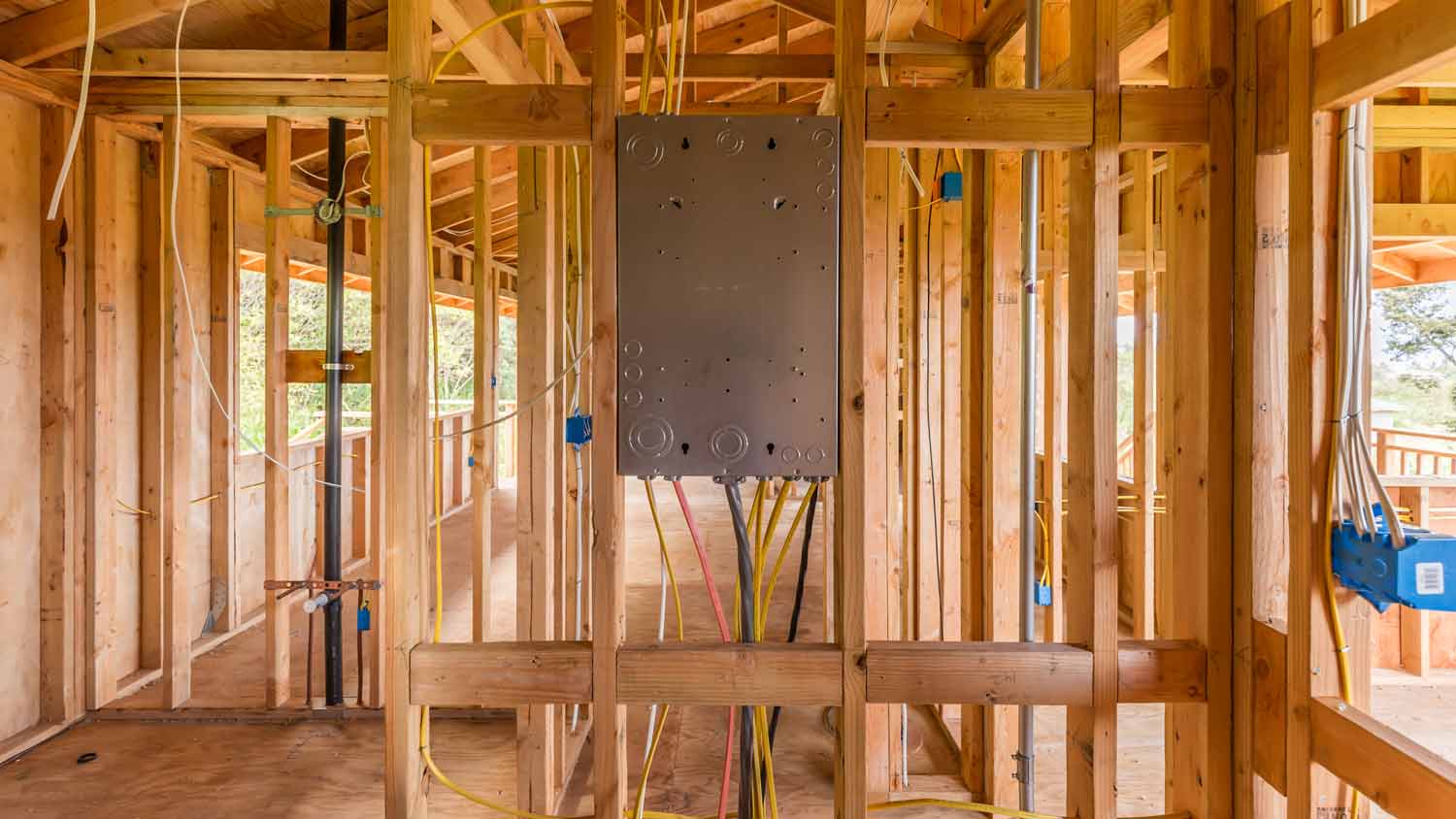Types of Electrical Boxes and How To Pick the Best One
Homeowners will typically encounter several electrical box types, and each type has its own best use-case scenarios


Electrical boxes are an essential part of any home electrical system. There are several types of electrical boxes, and they all house wiring connections, the parts of your electrical system where wires join an outlet, switch, or even other wires. These connections are especially fragile, and if damaged, pulled apart, or loosened, you could face a power outage or dangerous electrical fire. An electrical box will protect these crucial connection points from any potential issues.
There are a dizzying array of electrical box types on the market. But don’t worry: Most electrical boxes fall into nine main types, specializing in a load rating tailored to specific tasks and electric appliances.

1. Metal and Plastic Electrical Boxes
The majority of electric boxes are metal or plastic. Most indoor metal boxes are steel, while indoor plastic boxes are PVC or fiberglass. Weatherproof metal boxes for outdoor use are typically durable aluminum alloy. Some situations require a metal box over a plastic box, such as using a metal conduit to run wiring. If you are using a non-metallic cable to run wiring, like a Type NM-B (non-metallic sheathed cable), you can choose a metal or plastic container.
As a note, metal electrical boxes must connect to the system ground, typically via a short length of wire called a pigtail. Keep in mind that plastic boxes do not usually require such grounding.
Best use: Metal-sheathed cable or metal conduit for metal boxes; non-metallic cables for plastic boxes
2. Standard Rectangular Electrical Boxes
When you picture an electrical box, you will likely imagine a standard rectangular box. These electrical boxes protect the wires associated with single light fixture switches and standard power outlet receptacles. This type is also referred to as a single-gang or one-gang box, and they are generally 2 inches by 3 inches in size, with depths ranging from 1½ inches to 3½ inches. If you have a complex electrical setup, many rectangular boxes are “gangable,” meaning they feature detachable sides that allow multiple boxes to link together.
Standard rectangular boxes also come in new-work and old-work designs. Install a new-work box after the wall has been framed but before adding drywall. Install an old-work box, otherwise known as a retrofit box, after you finish the walls. Note that a standard electrical box used to enclose wire splices is called a junction box, which is installed in an accessible spot to make wire connections.
Best use: Light switches and outlets
3. 2-Gang, 3-Gang, and 4-Gang Electrical Boxes
You can join multiple standard rectangular boxes together to handle the electrical needs of numerous household electrical switches and outlets, or you can go with 2-gang, 3-gang, or 4-gang boxes.
As the names suggest, these electrical boxes are similar in function to rectangular boxes, but they are oversized to mount up to four devices side-by-side. Like standard rectangular boxes, you can find these in a variety of new-work and old-work designs. Some even have built-in cable clamps for convenience.
Best use: Multiple electrical devices joined together
4. Round Pan Electrical Boxes
Round pan boxes, also known as pancake boxes, tend to be shallow, at just ½ inch to ¾ inch deep. They’re best for ceiling or wall-mounted lighting fixtures that weigh no more than 50 pounds.
Ensure the fixture wires are properly connected and fitted. These are shallow boxes that can only fit two or three connections, and overstuffing them can lead to hot ceiling fixtures and, potentially, an electrical fire. If the setup demands more wire connections, go with a full-sized box.
Best use: Ceiling- or wall-mounted light fixtures, weighing less than 50 pounds
5. Octagon and Round Electrical Boxes
Octagon and standard round electrical boxes provide more room than shallow round pan boxes, with depths ranging from 1½ inches to 3 inches deep. This option is the most traditional choice for ceiling or wall-mounted lighting fixtures that weigh up to 50 pounds. Many round electrical boxes have fasteners, or “ears,” that can attach to the wall or ceiling surface so you can avoid cutting a large hole in the drywall. This feature makes them especially suited for old-work applications.
Best use: Ceiling- or wall-mounted light fixtures, weighing up to 50 pounds
6. 4-Inch Square Electrical Boxes
Standard square boxes, also known as 4-inch boxes, provide plenty of depth for multiple applications (1¼ inches to 2.125 inches). The square corners offer even more interior space for multiple conductors and connectors. For these reasons, square boxes are handy for running conductors in two or more directions. They attach to ceilings or walls and easily support lighting fixtures, housing switches, and related electrical receptacles.
Square electrical boxes also shine when used as a junction box, as they boast plenty of space to protect wire splices and the like.
Best use: Several conductors and connectors running in two or more directions
7. Ceiling Fan Electrical Boxes
These boxes are purpose-built for, you guessed it, mounting ceiling fans. They come in various types and sizes to suit different kinds of fans, though they are usually round. If you are installing a new ceiling fan, make sure the associated electrical box is UL-listed for ceiling fan mounting and marked “for use with ceiling fans.” Do not use a standard round or octagonal electrical box for mounting a ceiling fan, as they likely will not be able to withstand the dynamic loading of a rotating fan.
Best use: Ceiling fans weighing up to 70 pounds; light fixtures weighing between 90 and 150 pounds
8. Outdoor Electrical Box
These boxes are weatherproof and tailor-made for mounting to the surface of roof overhangs, decks, and exterior walls. If you have a complex backyard electrical setup with features like outdoor outlets, you likely have a few weatherproof outdoor boxes. Plastic outdoor boxes are usually high-impact PVC, and outdoor metal boxes are typically made from durable aluminum. Outdoor boxes must have a cover that has been rated for damp or wet locations.
Best use: Outdoor electricity
9. Covers and Box Extenders

It can help to learn a bit about box covers and box extenders. Electrical box covers enclose the front of the box, which is usually required by code. In other words, it is unsafe and typically illegal to leave an electrical box uncovered. Solid box covers are great for junction boxes or unused boxes, while those with cutouts can accommodate switches and outlets.
Box extenders, otherwise known as extension rings, come in a bunch of different shapes and sizes to match all of the aforementioned box types. They are box-shaped but have no back, as they attach to standard electrical boxes to increase the overall capacity. Box extenders can also bring a box flush with the drywall or ceiling for aesthetic and functional purposes.
How to Choose the Right Type of Electrical Box
Now that you know the electrical box options, it’s time to determine which one is best for your home electrical needs. Follow these guidelines to choose the best box for your project.
Determine the Electrical Box’s Purpose
Start by pinpointing the purpose of your future electrical box—what does it need to do? For example, if you need to mount a lightweight ceiling fan, you can narrow your options down to an octagon or round electrical box or a ceiling fan electrical box.
In general, it’s recommended to use plastic boxes for switches and receptacles. Metal boxes are ideal for powering light fixtures, and they are required when the current home wiring is metal clad cable and must be connected with the ground wire.
Old Work vs. New Work
If you’re replacing an electrical box, you’ll likely need an old-work system, whereas new installations typically require a new-work system. This distinction is essential to make before purchasing and installing another electrical system.
Consult a Professional Electrician
Before replacing or installing an electrical box, hire a local electrician to approve of your box type and install it. Electricians have the specialized knowledge and experience to give a professional recommendation on the right system for your home project.



.jpg?impolicy=leadImage)

- Home Generator Repair
- Lamp Repair
- Electric Repair
- Generator Installation
- TV Antenna Services
- Emergency Electricians
- Commercial Electricians
- Attic Fan Installation
- Attic Fan Repair
- Exhaust Fan Installation
- Electric Inspectors
- Subcontractors
- Electrical Construction
- EV Charger Installer
- Chandelier Installation
- Doorbell Installation
- Bathroom Fan Installation
- Ring Installers
- Electrical Panel Upgrade
- How Many Boxes Do I Need to Move? A Complete Guide
- How to Label Boxes for Moving: 9 Tips and Tricks
- How to Pack Boxes for Moving: 11 Tips to Try
- The 4 Keys to Finding and Using the Right Boxes For Your Move
- The Complete Moving Supplies List You Didn’t Know You Needed
- 8 Places to Track Down Boxes for Moving
- 5 Tips for Creating a Moving Box Inventory List
- What Is an Electrical Inspection and When Do You Need One?
- 20 Tools for Electrical Work To Keep In Your Toolbox
- How to Dispose of a Box Spring Properly















